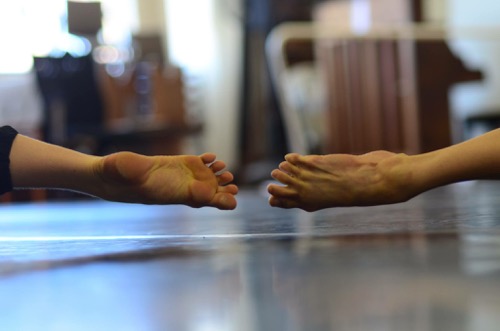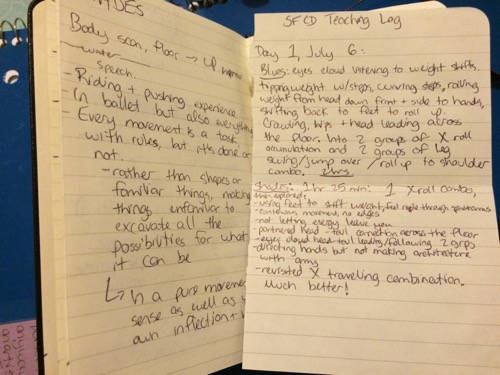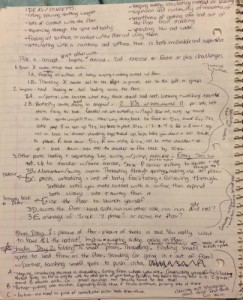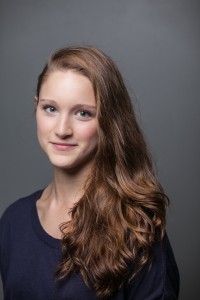
1. How did you first become involved in dance?
I’ve been dancing as long as I can remember.
After having seen me improv my way through the living room for years, my mother asked if I’d like to try a ballet class. I was eleven and I’ve been at it ever since.
2. When/how did you realize you wanted to become a professional dancer?
I attended the San Francisco Ballet’s summer program at 13 and would watch the company work and rehearse whenever I could find a moment to sneak to their studio door. It was thrilling.
There was something so beautiful about the way the dancers interacted, the sense of company life, and I decided it was something I wanted to experience.
3. Was there ever a time when you thought of quitting dance or second-guessed your decision to pursue a professional career? If so, what helped you through that time?
Honestly, no. My commitment to this field has been pretty unwavering.
My path was tumultuous at times, but through set backs, injuries, and disappointments, I’ve never felt like quitting. I’ve felt the need to shift my environment, or my role within the profession, but that to me is an exciting evolution.
I would recommend to any struggling dancer who is wondering if they should quit to ask themselves if perhaps they are just in the wrong place, or if they are trying to be something they are not. The dance world is vast! There are more options than we sometimes suppose.
I am now at a point where I am transitioning out of dancing full-time so that I can choreograph more, but even that feels like an evolution rather than a departure.
https://vimeo.com/218059438
4. When/how did you realize you wanted to pursue choreography?
It is hard to say when/how, I’ve always loved choreographing!
I have been super lucky to have the support of my choreographic work that I have received at Hubbard Street Dance Chicago and from my amazing boss Glenn Edgerton. I believe that Glenn has been instrumental in my journey to becoming a choreographer as he gave me the space, encouragement, and opportunities to truly nurture and find my voice. I’m incredibly grateful for that.
5. What inspires you as a choreographer?
Everything.
6. How would you describe your choreographic process?
My process is quite random, but always focuses on really using the dancers in the room.
I always strive to find the individualism in each artist, and unlock as much of their “personal genius” (something I believe each of us has) as I can. This means I seldom come in with too many preconceived notions about the piece I will make.
That being said, my movement is highly conceptual at its source, and is often directly derived from words or ideas. For example, I might ask a dancer “what is your favorite word?” or “what is the most amazing thing you have ever seen?” and then I shall construct a movement phrase out of their answer.
7. What’s the best advice you’ve received about choreography?
“Don’t hold anything back”
https://vimeo.com/218062887
8. What are some things you’d like to explore in your choreography career and dance career in the future?
I would like to work with a vast array of dancers, artists, and institutions. I love the unexpected and being put into contact with the unusual.
I would like to work with huge groups, with ballet dancers, with competition dancers, with non-dancers. I’d like to experiment with it all and to push the boundaries of what we think dance is.
I believe that as a creator it is paramount to create work that is inclusive and socially conscious and that breaks out of the often inappropriate antique norms that still exist in the art form.
As a dancer, I would like to continue to explore performing new and different work. Last year, Florian Lochner (a fellow Hubbard Street dancer and Choreographic Fellow) and I formed “Flock” which is a project in which we co-choreograph pieces that we then perform.
I am interested to grow this further and to see what that can open up for me as a performer. Dancing in our work is a particularly wild and satisfying experience and very different from the years I have spent in a rep company.
I also look forward to expanding “Flock” out further into the world and to see what that leads to.
9. You’re headed to Utah in May for SALT Contemporary Dance’s inaugural LINK dance festival. How did you first become connected with SALT?
SALT has been on my radar for some time as a place where I would love to create work. Their dancers are beautiful and varied and their mission is strong and inspiring. I was honored and excited to be asked to participate in their LINK festival.
10. What are you most looking forward about LINK?
The dancers! Like I said, I love being thrown into a studio with new dancers and this will be a particularly exciting process as our creation time is only a week! I am looking forward to see what we concoct!
https://vimeo.com/226251438
Disclosure: Rachel Hellwig serves as marketing director for SALT
















